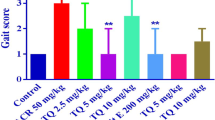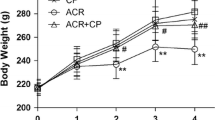Abstract
Occupational exposure and experimental intoxication with acrylamide (ACR) produce neuropathy characterized by nerve degeneration. To investigate the mechanism of ACR-induced neuropathy, male adult Wistar rats were given ACR (20, 40 mg/kg i.p. 3 days/week) for 8 weeks. Sciatic nerves were Triton-extracted and centrifuged at a high speed (100,000 × g) to yield pellet and supernatant fractions. The contents of six cytoskeletal proteins (NF-L, NF-M, NF-H, α-tubulin, β-tubulin, and β-actin) in both fractions were determined by sodium dodecyl sulfate-polyacrylamide gel electrophoresis (SDS-PAGE) and immunoblotting. Results showed that the three neurofilament (NF) subunits (NF-L, NF-M, NF-H) in both the pellet and the supernatant fraction decreased significantly (P < 0.01) in the high-dosing group, except for NF-M in the pellet. α-tubulin, β-tubulin, and β-actin increased significantly in the supernatant (P < 0.01), whereas both α-tubulin and β-tubulin decreased significantly in the pellet (P < 0.01). However, β-actin was not altered significantly in the sciatic nerves pellet. These findings suggest that ACR altered the cytoskeletal protein level in sciatic nerve, which may be one of the molecular mechanisms of ACR-induced peripheral neuropathy.


Similar content being viewed by others
References
Tareke E, Rydberg P, Karlesson P, Eriksson S, Tornqvist M (2000) Acrylamide: a cooking carcinogen? Chem Res Toxicol 13:517–522
LoPachin RM (2002) The role of fast axonal transport in acrylamide pathophysiology: mechanism or epiphenomenon? Neurotoxicology 23:253–257
Deng H, He F, Zhang S, Calleman CJ, Costa LG (1993) Quantitative measurements of vibration threshold in healthy adults and acrylamide workers. Int Arch Occup Environ Health 65:53–56
Edwards PM, Parker VH (1977) A simple, sensitive, and objective method for early assessment of acrylamide neuropathy in rats. Toxicol Appl Pharmacol 40:589–591
Spencer PS, Schaumburg HH (1974) A review of acrylamide neurotoxicity. Part II, experimental animal neurotoxicity and pathologic mechanisms. Can J Neurol Sci 1:170–192
Jellinger KA (2001) Cell death mechanisms in neurodegeneration. J Cell Mol Med 5:1–17
Ramaekers FC, Bosman FT (2004) The cytoskeleton and disease. J Pathol 204:351–354
Lee MK, Cleveland DW (1996) Neuronal intermediate filaments. Annu Rev Neurosci 19:187–217
LoPachin RM, Lehning EJ (1994) Acrylamide-induced distal axon degeneration: a proposed mechanism of action. Neurotoxicology 15:247–260
Gold BG, Griffin JW, Price DL (1992) Somatofugal axonal atrophy precedes development of axonal degeneration in acrylamide neuropathy. Arch Toxicol 66:57–66
Tandrup T, Jakobsen J (2002) Long-term acrylamide intoxication induces atrophy of dorsal root ganglion A-cells and of myelinated sensory axons. J Neurocytol 31:79–87
Kjuus H, Goffeng LO, Heier MS, Sjoholm H, Ovrebo S, Skaug V, Paulsson B, Tornqvist M, Brudal S (2004) Effects on the peripheral nervous system of tunnel workers exposed to acrylamide and N-methylolacrylamide. Scand J Work Environ Health 30:21–29
Le Quesne PM (1985) Clinical and morphological findings in acrylamide toxicity. Neurotoxicology 6:17–24
LoPachin RM, Ross JF, Lehning EJ (2002) Nerve terminals as the primary site of acrylamide action: a hypothesis. Neurotoxicology 23:43–60
Sickles DW, Stone JD, Friedman MA (2002) Fast axonal transport: a site of acrylamide neurotoxicity? Neurotoxicology 23:223–251
LoPachin RM, Ross JF, Reid ML, Das S, Mansukhani S, Lehning EJ (2002) Neurological evaluation of toxic axonopathies in rats: acrylamide and 2, 5-hexanedione. Neurotoxicology 23:95–110
Xie K, Gupta RP, Abou-Donia MB (2001) Alteration in cytoskeletal protein levels in sciatic nerve on post-treatment of diisopropyl phosphorofluoridate (DFP)-treated hen with phenylmethylsulfonyl fluoride. Neurochem Res 26:235–243
Uchida A,Tsuda M, Tashiro T, Komiya Y, Yorifuji H, Kishimoto T, Hisanaga S (2004) Morphological and biochemical changes of neurofilaments in aged rat sciatic nerve axons. J Neurochem 88:735–745
Zhang T, Zhao X, Zhu Z, Yu L, Han X, Zhang C, Xie K (2005) 2,5-Hexanedione induced decrease in cytoskeletal proteins of rat sciatic-tibial nerve. Neurochem Res 30:177–183
Shea TB, Dahl DC, Nixon RA, Fischer I (1997) Triton-soluble phosphovariants of the heavy neurofilament subunit in developing and mature mouse central nervous system. J Neurosci Res 48:515–523
Cohlberg JA, Hajarian H, Tran T, Alipourjeddi P, Noveen A (1995) Neurofilament protein heterotetramers as assembly intermediates. J Biol Chem 270:9334–9339
Shea TB, Sihag RK, Nixon RA (1990) Dynamics of phosphorylation and assembly of the high molecular weight neurofilament subunit in NB2a/d1 neuroblastoma. J Neurochem 55:1784–1792
Ackerley S, Thornhill P, Grierson AJ, Brownlees J, Anerton BH, Leigh PN, Shaw CE, Miller CC (2003) Neurofilament heavy chain side arm phosphorylation regulates axonal transport of neurofilaments. J Cell Biol 161:489–495
Jacomy H, Zhu Q, Couillard-Despres S, Beaulieu JM, Julien JP (1999) Disruption of type IV intermediate filament network in mice lacking the neurofilament medium and heavy subunits. J Neurochem 73:972–984
Lehning EJ, Jortner BS, Fox JH, Arezzo JC, Kitano T, LoPachin RM (2000) Diketone peripheral neuropathy: I. Quantitative morphometric analyses of axonal atrophy and swelling. Toxicol Appl Pharmacol 165:127–140
Zhao XL, Zhu ZP, Zhang TL, Zhang CL, Yu LH, Xie KQ (2004) Tri-ortho-cresyl phosphate (TOCP) decreases the levels of cytoskeletal proteins in hen sciatic nerve. Toxicol Lett 152:139–147
Lehning EJ, Persaud A, Dyer KR, Jortner BS, LoPachin RM (1998) Biochemical and morphologic characterization of acrylamide peripheral neuropathy. Toxicol Appl Pharmacol 151:211–221
Muma NA, Slunt HH, Hoffman PN (1991) Postnatal increases in neurofilament gene expression correlate with the radial growth of axons. J Neurocytol 20:844–854
Zhu Q, Couillard-Despres S, Julien JP (1997) Delayed maturation of regenerating myelinated axons in mice lacking neurofilaments. Exp Neurol 148:299–316
Elder GA, Friedrich VL Jr, Bosco P, Kang C, Gourov A, Tu PH, Lee VM, Lazzarini RA (1998) Absence of the mid-sized neurofilament subunit decreases axonal calibers, levels of light neurofilament (NF-L), and neurofilament content. J Cell Biol 141:727–739
Yamasaki H, Itakura C, Mizutani M (1991) Hereditary hypotrophic axonopathy with neurofilament deficiency in a mutant strain of the Japanese quail. Acta Neuropathol 82:427–434
Julien JP (1999) Neurofilament functions in health and disease. Curr Opin Neurobiol 9:554–560
Kriz J, Zhu Q, Julien JP, Padjen AL (2000) Electrophysiological properties of axons in mice lacking neurofilament subunit genes: disparity between conduction velocity and axon diameter in absence of NF-H. Brain Res 885:32–44
He FS, Zhang SL, Wang HL, Li G, Zhang ZM, Li FL, Dong XM, Hu FR (1989) Neurological and electroneuromyographic assessment of the adverse effects of acrylamide on occupationally exposed workers. Scand J Work Environ Health 15:125–129
Shea TB (2000) Microtubule motors, phosphorylation and axonal transport of neurofilaments. J Neurocytol 29:873–887
Yabe JT, Chan WK-H, Chylinski T, Lee S, Pimenta A, Shea TB (2001) The predominant form in which neurofilament subunits undergo axonal transport varies during axonal initiation, elongation and maturation. Cell Motil Cytoskeleton 48:61–83
Hartley CL, Anderson VE, Anderton BH, Robertson J (1997) Acrylamide and 2,5-hexanedione induce collapse of neurofilaments in SH-SY5Y human neuroblastoma cells to form perikaryal inclusion bodies. Neuropathol Appl Neurobiol 23:522–534
Ho WH, Wang SM, Yin HS (2002) Acrylamide disturbs the subcellular distribution of GABAA receptor in brain neurons. J Cell Biochem 85:561–571
Endo H, Kittur S, Sabri MI (1994) Acrylamide alters neurofilament protein gene expression in rat brain. Neurochem Res 19:815–820
Yu S, Zhao X, Zhang T, Yu L, Li S, Cui N, Han X, Zhu Z, Xie K (2005) Acrylamide-induced changes in the neurofilament protein of rat cerebrum fractions. Neurochem Res 30:1079–1085
Gupta RP, Abou-Donia MB (1997) Acrylamide and carbon disulfide treatments increase the rate of rat brain tubulin polymerization. Mol Chem Neuropathol 30:223–237
Perrone Capano C, Pernas-Alonso R, di Porzio U (2001) Neurofilament homeostasis and motoneurone degeneration. Bioessays 23:24–33
Yagihashi S, Kamijo M, Watanabe K (1990) Reduced myelinated fiber size correlates with loss of axonal neurofilaments in peripheral nerve of chronically streptozotocin rats. Am J Pathol 136:1365–1373
Liuzzi FJ, Bufton SM, Vinik AI (1998) Streptozotocin-induced diabetes mellitus causes changes in primary sensory neuronal cytoskeletal mRNA levels that mimic those caused by axotomy. Exp Neurol 154:381–388
Acknowledgments
This work was supported by grants from the Ministry of Science and Technology of China (No. 2002CB512907), and National Natural Science Fund of China (No. 30271138), and Young Excellence Fund of Shandong Province, China (No.02B5080).
Author information
Authors and Affiliations
Corresponding author
Rights and permissions
About this article
Cite this article
Yu, S., Son, F., Yu, J. et al. Acrylamide Alters Cytoskeletal Protein Level in Rat Sciatic Nerves. Neurochem Res 31, 1197–1204 (2006). https://doi.org/10.1007/s11064-006-9176-x
Received:
Accepted:
Published:
Issue Date:
DOI: https://doi.org/10.1007/s11064-006-9176-x




